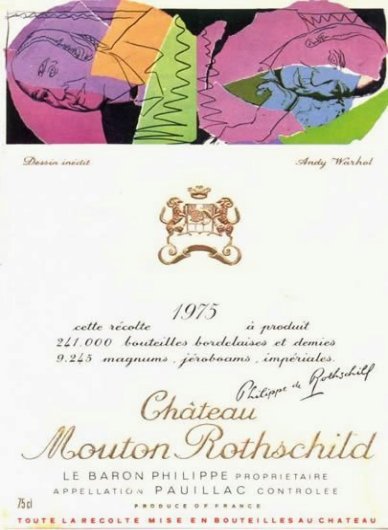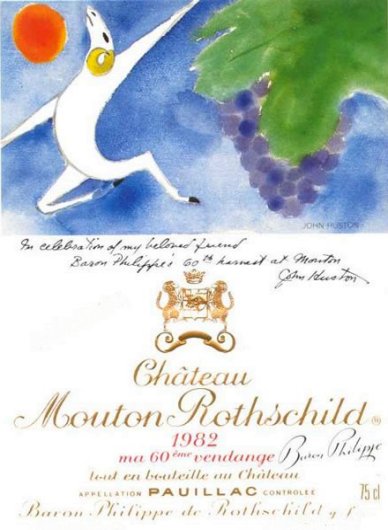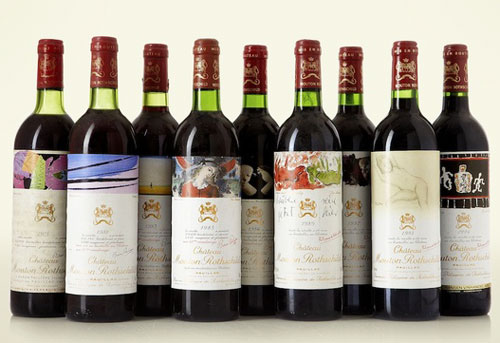Continued from Part 1 of Wine Label Art
In an ocean of wine, the label is the siren song that says, “Take me home with you.”
For many of us, buying wine is an exercise in shallowness: we think pretty pictures must mean good wine. We find fluffy creatures endearing.
We believe the winery actually used those glistening grapes. We long to share that pastoral landscape or partake of château life. Like most marketing, wine labels are intensely aspirational.
(That’s probably why we have yet to see one featuring someone passed out on the floor.)
But it wasn’t always so. In The Oxford Companion to Wine, Jancis Robinson says that l abels were first used around 1860, when merchants started selling wine in glass bottles and there were glues strong enough to attach the labels.
abels were first used around 1860, when merchants started selling wine in glass bottles and there were glues strong enough to attach the labels.
But these were no works of art, just blunt statements indicating the merchant, producer, region and year. And they remained virtually the same for another sixty years.
Then in 1924, just two years after Baron Philippe de Rothschild became the proprietor of his family’s esteemed Bordeaux estate, Château Mouton Rothschild, the 22-year-old took the first of his revolutionary steps: he bottled his wine at the château rather than sending it in barrels to be bottled by the merchants who sold it.
His next innovation was to create his own label, commissioning a poster artist Jean Carlu to design it. (There’s a Canadian connection: Carlu also designed the Art Deco theatre and reception space atop the College Park stores in Toronto, still called “The Carlu.”)
For Rothschild’s label, Carlu incorporated a stylized ram’s head, partly as a nod to the baron’s astrological sign (he was an Aries) and partly to acknowledge the family name Mouton (which means sheep or ram). 
Below the head is a Cubist image of a fan of arrows representing the lineages of the Rothschild family. For the first time, the producer’s name, rather than the merchant’s, was prominent.
Other Bordeaux châteaux soon followed suit, gaining recognition for their own names and financial freedom from the powerful merchants.
Rothschild used this label until 1945, when World War II ended. To celebrate the occasion, artist Philippe Jullian created a design incorporating Winston Churchill’s two-fingered “V” for victory sign.
Almost every year after that, Rothschild commissioned a different artist to design his label including: Jean Cocteau (1947), Georges Braque (1955), Salvador Dali (1958), Georges Mathieu (1961), Henry Moore (1964), Joan Miró (1969), Marc Chagall (1970), Andy Warhol (1975) and Keith Haring (1988).
Of special note was Pablo Picasso’s 1973 design to celebrate the winery’s elevation from second-growth to first-growth status in the Bordeaux classification of wines.
 It was the only change ever made to the famous ranking dating back to 1855—a tribute both to the quality of the wine and to the baron’s tireless harassment of French authorities.
It was the only change ever made to the famous ranking dating back to 1855—a tribute both to the quality of the wine and to the baron’s tireless harassment of French authorities.
In 1978, Montreal artist Jean-Paul Riopelle created two versions of the label, both variations on the wine stains left by the bottom of wine bottles.
Rothschild couldn’t decide between them, so he used both, making bottles from that vintage even more valuable to collectors.
In 1982, to commemorate what the powerful American critic Robert Parker dubbed “the vintage of the century,” John Huston painted a watercolor image of a ram dancing joyfully next to a bunch of grapes under a blue sky and orange sun.
For the 1999 vintage, artist Raymond Savignac used “le gag visual”: a frisky ram in a woolly orange sweater kicking up his hind legs.
There were only two years when no original was commissioned. In 1953, the label bore a portrait of the family patriarch, Baron Nathaniel Rothschild, to mark the centenary of the family’s purchase of the estate.
And in 1977, a label with words and no art honored the Queen Mother, who had stayed at the château that year.
The tradition continues today: the baron’s daughter, Baroness Philippine de Rothschild, still commissions labels from artists.
Surprisingly, none has ever been paid cash; they were all reimbursed instead with five cases of the wine. That’s not a bad deal when you consider that the latest vintage retails for about …
Read Part 3 of Wine Label Art








